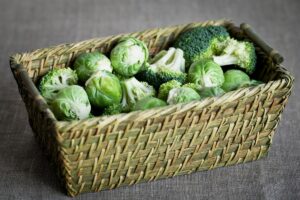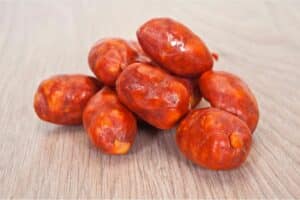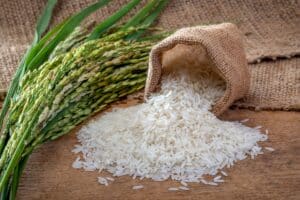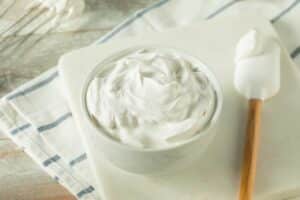When mustard lovers want to turn up the heat, chances are they’ll reach for something like Dijon or spicy brown mustard. Both varieties are highly popular—not to mention extremely delicious—but how do they compare?
Today, we’re going to take a look at spicy brown mustard and Dijon. We’ll go over everything you need to know about the two, whether they’re interchangeable and where each one shines.
Spicy Brown Mustard vs Dijon
The main difference between spicy mustard and Dijon is the liquid with which the ground mustard seed plants are combined. Dijon mustard seeds are typically combined with unripe grapes while spicy brown mustard uses vinegar, which produces a different flavor profile.
- Flavor: Both have intense flavor profiles, but spicy brown mustard delivers a more intense taste than Dijon.
- Uses: Dijon works best in sauces and marinades, while spicy brown mustard is more at home in a meat-filled sandwich.
- Heat: Both are hotter than regular mustard, but spicy brown mustard is spicier than Dijon.
- Consistency: Dijon mustard is smooth, whereas the consistency of spicy brown mustard is coarse (thanks to its whole and partially ground grains). Dijon is more of a fine paste, while spicy brown mustard has a bit of texture. You can usually see pieces of ground-up mustard seeds in spicy brown mustard
- Appearance: You can generally distinguish the two by looking at the color. Dijon is typically lighter, whereas spicy brown mustard is a darker yellow.
You may also be interested in: Cinnamon sticks vs ground cinnamon comparison.
Comparison Table Between Spicy Brown Mustard and Dijon
| Dijon Mustard | Spicy Brown Mustard | |
| Flavor | Tangy, spicy | Pungent, spicy |
| Uses | Marinades, sauces | Deli meat sandwiches |
| Heat | Hot | Hotter |
| Consistency | Smooth | Coarse |
| Appearance | Light | Dark |
Can You Substitute Spicy Brown Mustard for Dijon?
In many cases, you can swap Dijon for spicy brown mustard (use it as a 1 for 1 substitution), but it won’t always make a perfect replacement. Depending on the substitution you make, the final flavor of your dish may vary a bit:
Here’s what you need to know before you run out to the grocery store to buy mustard (or not).
- Texture. Pay particular attention to texture, as using spicy brown mustard in place of Dijon in a recipe will change it considerably. If the texture doesn’t matter, go ahead and use spicy brown mustard. But if your end goal is smooth and creamy (like if you’re making a sauce), it’s best to look for a different substitute.
- Flavor. Dijon is intense and sharp like spicy brown mustard, but less so. Making this substitution will create a much stronger flavor profile in your dish, which is something to be aware of. If you’re worried about the taste but have nothing else, go ahead and use the spicy brown mustard—simply reduce the ratios.
- Heat. The final thing to keep in mind is the heat profile of the dish you’re making. Spicy brown mustard adds considerable heat, which may change the flavor profile of your dish. It may also be too spicy for some people, so keep your diners’ preferences in mind when making the swap.
Appropriate Substitutes for Dijon Mustard
The most common swap for Dijon mustard is yellow mustard, which works well—plus, it’s affordable, and most people generally have it on hand. You can also substitute any of the following ingredients in a recipe that calls for Dijon mustard:
- Honey mustard
- Egg yolks
- Mayonnaise
- Wasabi
Or, if you’re feeling creative, you can try making your own Dijon mustard! It’s easy to do, and you probably already have the ingredients on hand. Just mix the following:
- 1 ½ tablespoon of mayonnaise
- 1 tablespoon of dry mustard powder
- ¾ tablespoon of white wine vinegar
You can also add a pinch of salt and a pinch of sugar to the mixture to jazz things up.
Appropriate Substitutes for Spicy Brown Mustard
What about if you’ve run out of spicy brown mustard? The best choice is Dijon, but stone-ground mustard works well if you don’t have Dijon either. And if you’re really in a pinch, standard yellow mustard will also suffice, as will horseradish, turmeric, and chili peppers.
What Is Spicy Brown Mustard?
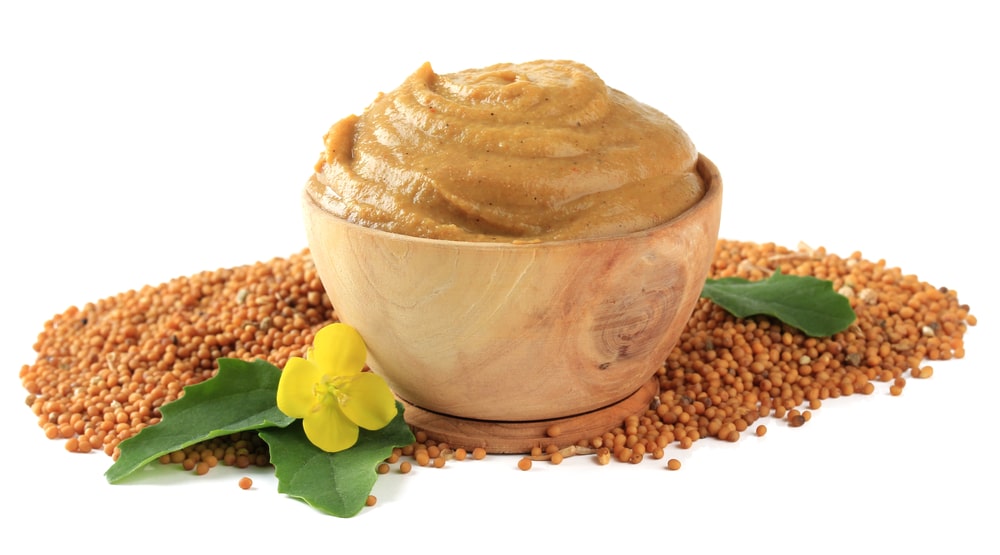
To understand what spicy brown mustard is, it’s best to compare it to traditional mustards. Regular yellow mustards are made using finely ground yellow mustard seeds, while the spicy brown varieties are made using brown mustard seeds. Brown mustard seeds have natural heat and are darker than yellow mustard seeds.
Another critical distinction between spicy brown mustard and standard versions is that the former is soaked in less vinegar. When you combine these seeds with less vinegar, the spice shines through. (As anyone who’s ever tried spicy brown mustard can attest to!).
In terms of taste, some people describe spicy brown mustard as having a malty taste. Its mouthfeel is coarse thanks to the high number of mustard seeds, and it’s also quite pungent. Spicy brown mustard plays well with spices like ginger, nutmeg, and cinnamon, which add earthy tones and are quite commonly added to deepen the flavor profile.
It’s also easy to distinguish spicy brown mustard by sight alone. You’ll see that the bran from the mustard seeds has been left on, which gives the condiment a thicker, coarser texture.
How to Use Spicy Brown Mustard
Spicy brown mustard leaves no one indifferent, and its intense flavor profile has earned it the distinction of being a deli mustard favorite.
It holds its own against deli meats that also have a lot of flavors, so this is where you’re most likely to enjoy spicy brown mustard. Head to your local deli, and you’re sure to find it piled on big meaty sandwiches such as corned beef, pastrami, and roast beef. It cuts through the fattiness of these meats and goes excellently with their seasonings.
Another place to use spicy brown mustard is in potato salads and coleslaws, a personal favorite of many chefs thanks to the depth it adds to these dishes. It can be especially intense if you pair it with other rich flavors, like horseradish.
If you’re a fan of sauerkraut or sausages, spicy brown mustard pairs perfectly with these foods. Lots of people also enjoy dipping a nice warm pretzel in spicy brown mustard. Or, if you just prefer some extra heat, it’s an excellent all-purpose swap for yellow mustard.
What Is Dijon Mustard?
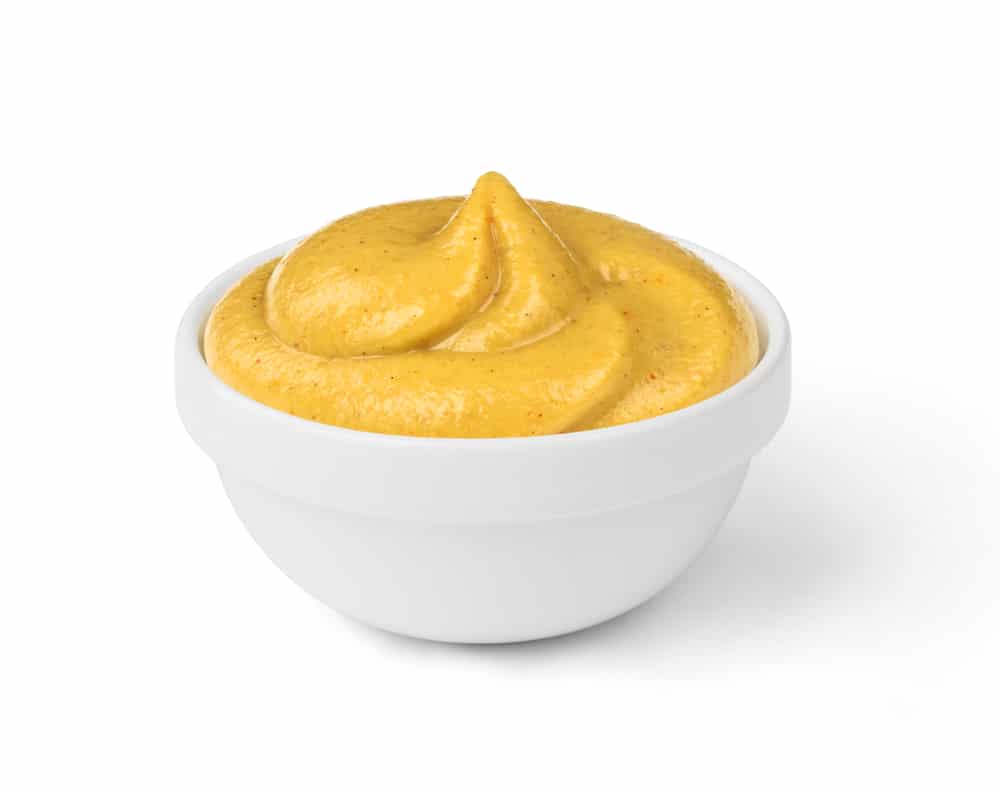
As you probably already know, Dijon mustard originated in Burgundy, France. A man named Jean Naigeon created the version that we know today back in 1856 (though it was used as a condiment as early as the 1300s!).
Instead of using vinegar, Naigeon used what’s known as verjuice to make the mustard. Verjuice is an acidic juice that comes from unripe grapes, which is less acidic than normal vinegar. The result when using this method is changes in the flavor profile. Namely, the mustard becomes deeper, hotter, and has a stronger flavor.
While the verjuice method of making mustard revolutionized it, nowadays most Dijon mustards are made with different low acidity liquids. White wine is the most common. Another change is the use of hotter brown or black mustard seeds.
And although Dijon mustard originated in France, its production is not limited to this country. You can find Dijon mustards just about everywhere in the world, and it’s no surprise why. Dijon is insanely popular due to its beautiful flavor profile (tangy, somewhat spicy) and versatility.
How to Use Dijon Mustard
Part of the beauty of Dijon mustard is that you can use it in pretty much any dish that calls for yellow mustard. Making this swap gives a dish a more intense mustard flavor, though not as intense as spicy brown mustard. Dijon mustard is particularly well-loved thanks to its ability to pump up things like mayonnaise, sauces, and vinaigrettes or marinades.
It works particularly well in sauces. For example, if you’re making macaroni and cheese, try adding a little Dijon mustard to the cheese sauce. You can also add it to your meat sauces for a bit of a kick.
When it comes to making homemade mayonnaise, plenty of people like to swap Dijon mustard for the mustard component. Doing so gives the mayonnaise a bit of heat without affecting the smooth consistency you expect from mayonnaise.
And, of course, Dijon mustard is the star of vinaigrettes and marinades. Its smooth consistency works fantastically in just about any salad dressing or marinade, as it blends perfectly and even helps keep the oil and vinegar from separating.


